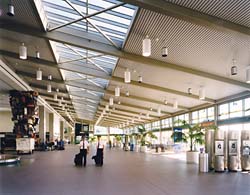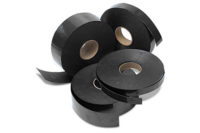
Exposed structural steel adds a dramatic element to the design of many modern buildings. The exposed structure adds strength and drama to spaces such as atria and meeting spaces. Classic examples of designs with exposed structural steel include the atria at the New York Psychiatric Institute and the World Trade Centre East, in Boston, and the extensive exposed steel at JFK's new International Arrivals Terminal 4.
Readers might ask, "How is this accomplished when structural steel needs to be fireproofed to protect it from fire?" The answer is decorative thin-film intumescent fire-resistive coatings for structural steel.
Since the late '80s, North America has seen an increasing trend in the use of decorative thin-film intumescent fire-resistive coatings for the protection of structural steel in buildings. This trend will likely continue because of the superior aesthetic and physical characteristics offered by these products compared to traditional fire protection methods. Designers can now express the structure as an art form in buildings and at the same time satisfy building code requirements for fire-resistance ratings. Whereas they were once considered cost prohibitive, increased usage, competition and resulting economies of scale have reduced costs so that use of thin-film intumescent fire-resistive coatings merits serious consideration.

on structural steel
Architect: Ellerbe Becket Photo by: Lenscape Inc.
Film description
Thin-film intumescent fire-resistive coatings are paint-like in their application and appearance. Typical dry-film thickness ranges from as little as 16 mils (0.4 mm) up to 200 mils (5.0 mm), although thicknesses greater than this are published for some products in some fire test designs. Intumescence is a thermal-chemical process whereby exposure of a material to heat causes it to swell with a resulting dramatic increase in volume and thickness. With thin-film intumescent fire-resistive coatings, the resulting ash can be 20 to 50 times greater in thickness than the original coating. That ash insulates the steel from fire and extends the time to occurrence of critical temperatures where the load carrying capacity of the structure would be compromised. Thus, the heat of fire changes the thin-film intumescent product from a decorative coating to a fire-resistive insulation.The thickness of fire-resistive material that is required for any particular situation depends on the fire-resistance rating that is required by the applicable building code and the size of the structural steel section that is being protected. The fire protection industry usually sizes structural steel by W/D and A/P ratios where W is the weight of the steel section (pound per foot), A is the cross sectional area of the steel section (inches squared). and D and P are the heated perimeter of the section (inches). The heated perimeter is that portion of the perimeter of the steel cross section that would be exposed to a fire. Generally, as steel size or W/D or A/P increases, the inherent fire resistance of the section increases and the thickness of fire-resistive material required for a given rating decreases. Therefore, careful selection of steel sizes can result in thinner and more economical fire protection thickness. Furthermore, it is imperative that the minimum steel size limitations specified in the published fire-rated designs be satisfied.
Like most elements and materials in buildings, the properties of structural steel change at elevated temperatures. At temperatures of 600 degrees C, steel retains only about 50 percent of its original design strength. If the structure of a building was left unprotected and it were exposed to fire, the worst-case scenario would be collapse of the building as the load carrying ability of the structure becomes compromised. Fortunately, collapse of protected steel buildings has been a rare occurrence in North America. The collapse of Building No. 7 of the World Trade Center on Sept. 11 was the first documented case of a protected steel building in North America that has collapsed as the result of fire. This is testimony to the historic value and performance of directly applied fire-resistive materials and to the merits of our North American building code, testing standards and fire-resistive rating system.
Building code development
Building Codes in North America have developed around the concept of compartmentization. That is: Reduce the risk of fire to life and property by dividing the building into fire compartments formed by fire-resistive wall, floor and roof assemblies. The fire-resistive assemblies and their structural components are required to resist fire to a degree that is commensurate with the level of risk of fire to life and property that is associated with the particular use or occupancy of the building. That degree of fire protection is quantified by fire resistance ratings that are determined by standard fire exposure tests and expressed in terms of hours or fractions thereof.The fire test standards that are most widely referenced in North American building codes are ASTM E-119 (U.S.) and CAN/ULC-S101 (Canada). Testing laboratories and certification agencies publish the results of proprietary fire tests as fire rated designs in directories or handbooks such as UL's Fire Resistance Directory. For the most part, published fire test designs indicate the precise nature and dimensions of full-scale assemblies as tested. Certain tolerances, minimums, maximums and variations may be identified if supported by sound engineering judgment and/or test data.
When specifying fire-resistive materials for structural steel, it is imperative to select products that have been tested in accordance with the appropriate standards and to select a fire test design that best represents the site conditions including steel sizes. Furthermore, all life safety products should be independently certified by an accredited certification agency, as evidenced by the agency' s label or listing mark on the product itself.
Their ability to provide required fire resistance ratings is just one attribute of thin-film fire resistive intumescent coatings. As the photographs that accompany this article attest, they perform a decorative function that is unparalleled by board systems and conventional directly applied fire-resistive materials. Additional benefits and features vary by product and include:
• Thin film - smaller column footprints, less dimensional intrusion into the room space, less interference with pedestrian movement.
• High Durability - extremely hard, impact and abrasion resistant.
• Finish - smooth, dust-free and can be cleaned.
• Color - some systems offer topcoats with virtually unlimited color range.
• Lightweight - add less weight to building than gypsum board or conventional sprayed fire resistive materials.
• Environment - Zero VOC and low off-gassing products available.
• Trained applicators -formal contractor training program (some manufacturers).
With these many attributes, increasing awareness and product choices, improving cost/benefit ratios and broader range of fire test designs, decorative thin-film intumescent fire resistive coatings will continue to play in increasingly important role in the design of modern buildings.


Report Abusive Comment